MWM Spartan 2.0: Loveable electric 4×4 is a tad too dear
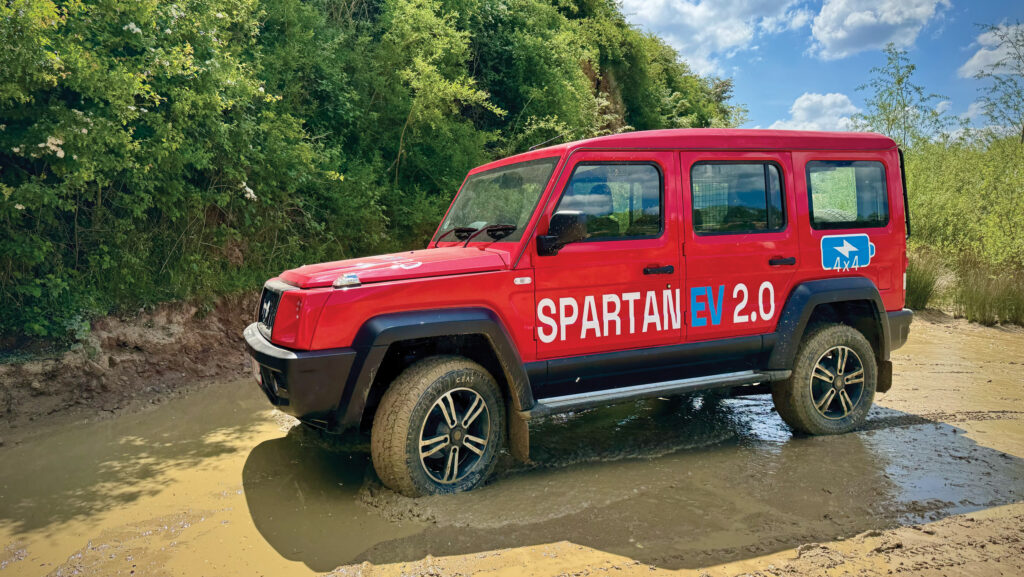 © MAG/Oliver Mark
© MAG/Oliver Mark The second coming of Spartan, the little-known electric 4×4, has been a saga so rich in drama that it could be ripe for a big screen adaptation.
Opening scenes commence with jollity, as an enterprising automotive start-up – Czech outfit Maurice Ward Motors (MWM) – seals a deal to import its first car, a Russian-made UAZ Hunter 4×4, to Europe.
Frantic in-house beavering follows, as the petrol engine and five-speed gearbox of the rechristened Spartan 1 are hoicked out, and batteries and motors bolted in and wired up.
See also: On test: Toyota’s super-frugal Rav4 plug-in hybrid
MWM Spartan 2.0 five-door
- Motor 130kW
- Battery pack 61kWh
- Max torque 1,075Nm
- Claimed range 142 miles
- Kerb weight 2,560kg
- Wading depth 700mm
- Towing capacity 3,000kg
- Price £53,505 ex VAT (three door £48,995 ex VAT)
The company homes in on a perceived untapped market for off-road EVs, flogging six in the UK in little more than a year.
Then, as MWM’s metaphorical ducks settle in an orderly line, the plot twists.
Putin’s missiles send them flapping in wild frenzy, trade with Russia is outlawed and the Slavic UAZ migration route slams shut. The company finds itself carless almost overnight. Panic ensues.
Out march the heroes of the hour, played by a delegation of MWM execs, on an expedition to find a replacement. Their hunt winds up in Pune, India – home of the diesel-powered Force Gurkha.
Cue pen meeting paper, and the birth of Spartan 2.0.
What’s different?
This is a very different beast to the previous jalopy. And that’s a good thing, as it was a Soviet-era relic.
By MWM’s own admission, it was a marriage of convenience: robust Russian workhorse meets prospective EV developer without squillions to throw at ground-up development.
First impressions suggest it’s on sounder footing this time around, with the three- and five-door Gurkhas having been recently updated and equipped with the latest mod-cons.
The ladder chassis, shell and interior components of these vehicles are shipped to MWM’s base in Pilsen.
As with the UAZ, the EV mutation sees the Czechs fit the batteries, motors and associated hardware, including a new digital dash, in-house. Handily, there’s no right-hand drive conversion required on this occasion.
Vehicles are built to order, with waiting times of about six months.
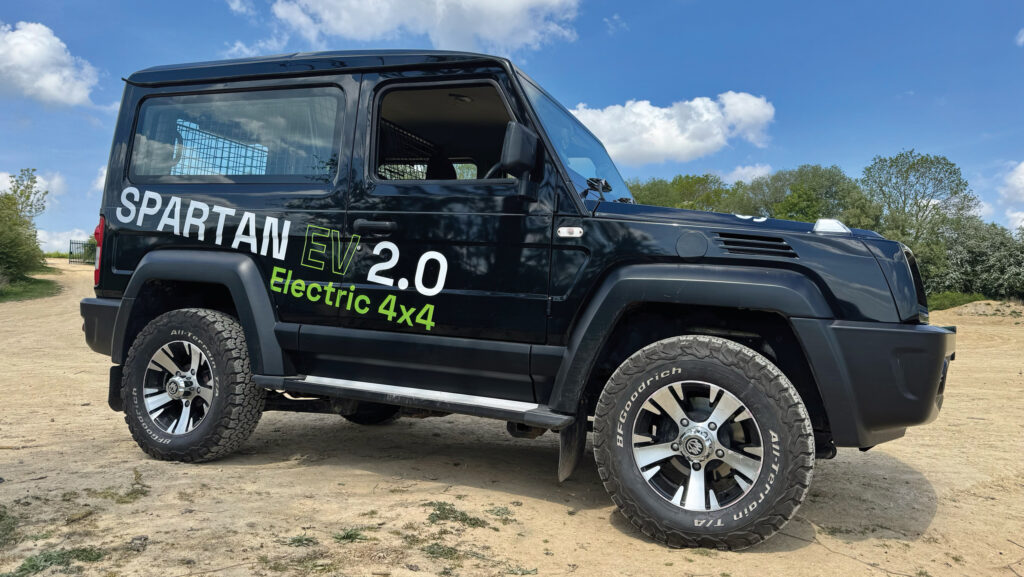
Three-door variant © MAG/Oliver Mark
Much to look at?
The Spartan appears a pastiche of two esteemed off-roaders – three parts Mercedes G-Wagon to one part Suzuki Jimny.
Like them, it’s clad in uncompromisingly angular tinwork rather than frumpy SUV curves, with a breeze block-square silhouette and a windscreen as upright as a saluting soldier.
Compact proportions keep the wheels at the corners and overhangs short, resulting in slope-taming approach, breakover and departure angles.
Adding to the no-nonsense look are straight-edged wheelarches that surround 18in wheels, most commonly shod with either BF Goodrich ATs or the harder compound of a Cooper AT3.
And, behind, an exposed spare wheel clings to a side-swinging tailgate that grants access to cargo and, in the curious case of the three-door variant, the second row of seats.
Colour options are limited to a palette of four: red, green, white or black.
More of a dilemma might be the choice of model, either the three-door short-wheelbase (SWB) or five-door long (LWB).
The former can be had with two or four seats and the latter up to six – albeit leaving space for just a pencil case in the “boot”.
None offers a third seat in the middle row, so the spread of cushioned armchairs gives off something of a nursing home vibe.
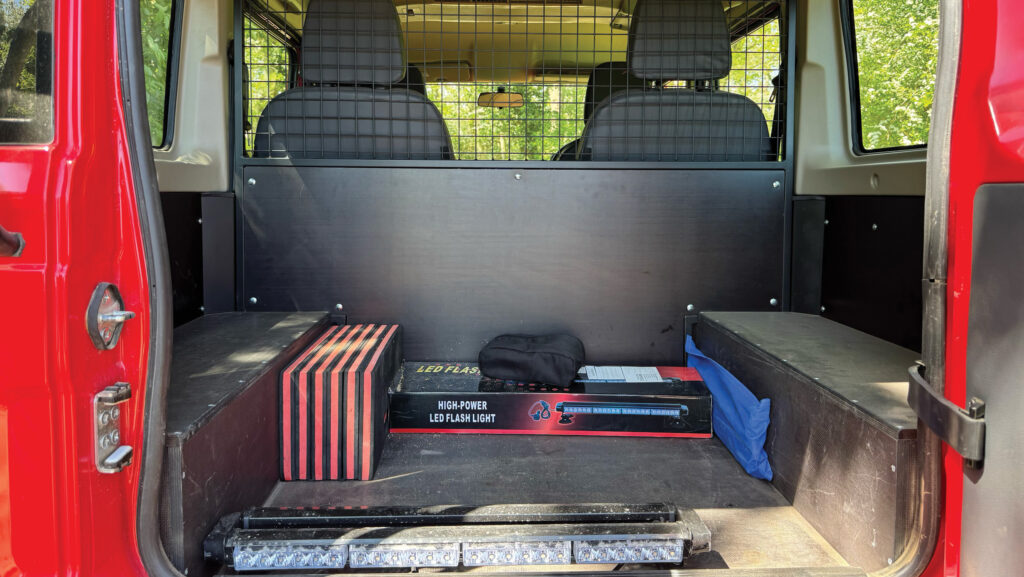
© MAG/Oliver Mark
One of the quirks of buying a ready made platform is that it’s cheaper to spec the maximum number of seats in either model.
Buyers must cough up £490 to remove the rear pair in the LWB, and £1,490 to make it a two-seater.
Opting to do so sees the cargo area lined with “marine grade” ply; gloriously durable and easy to replace, but not exactly befitting the circa £54k asking price.
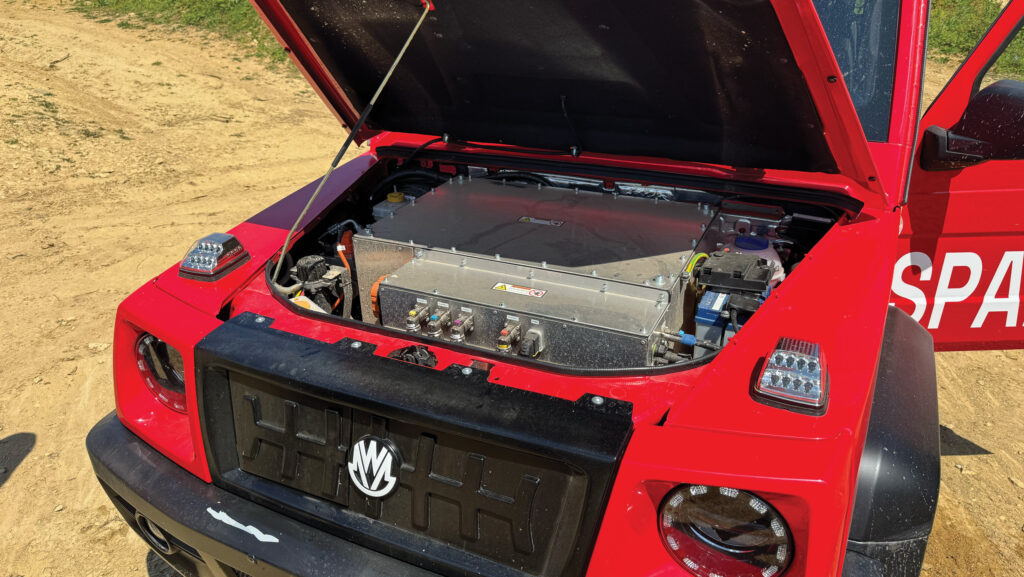
© MAG/Oliver Mark
What about the range?
Many readers will hold uncharitable views about electric vehicles, in part because of their limited range relative to a petrol or diesel.
And that certainly applies here, as the relatively small 61kWh battery pack has been selected to slot in the restricted space of the redundant engine bay, as opposed to a more conventional position on the belly.
The benefit of this setup is an unfettered ground clearance of 240mm, but miles per charge are hobbled as a result – 150 on the SWB, 142 on the slightly heavier LWB.
Those figures drop to nearer 125 miles for motorway driving.
A “dynamic” range read-out does little to remedy any dead battery anxiety. The figure wanders wildly depending on the direction of the wind, and whether you’re speeding up, slowing down or in hill descent mode.
Such is its tendency to drift that drivers are better off guestimating how far they’ve got left based on the battery charge percentage.
Towing will clip the Spartan’s wings further. Power is certainly no issue when maxing out the 3t limit, but it may well halve the expected range.
No matter, says MWM, as this is an off-road workhorse rather than a luxury SUV and, for many prospective buyers, road miles will be the exception rather than the norm.
As for cell replenishment, a 90kW rapid charger will get it from 20% to 80% in under 30mins.
Handily, a three-pin plug adaptor for the front grille charging port also means the on-board batteries can be used to run power tools. At £1,599 ex VAT, this “vehicle to load” system is the most expensive optional extra.
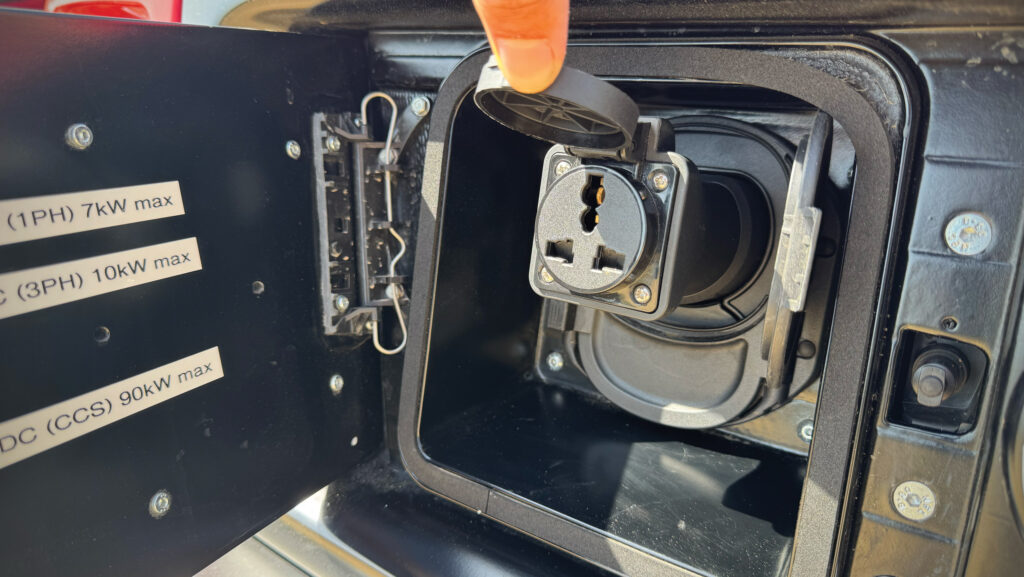
Vehicle to load adapter © MAG/Oliver Mark
Is it powerful?
Electrons are sent to a single 130kW motor in place of the gearbox.
This puts out a staggering 1,075Nm of torque, which is roughly on par with the 6-litre Deutz engine of a Fendt 724.
Not that you’d know if from the driver’s seat, with the Czechs having spent plenty of time fettling the power delivery to avoid the lot being served up in one torquey frenzy.
From there, things take a more conventional route. Unlike most EVs, the Spartan’s motor sends its power directly into a transfer case, leaving the final stages of the driveline entirely mechanical.
This includes a selectable four-wheel drive system, complete with a low-range box for crawling and manually locked differentials front and rear, yoked by old-hat, yank-to-engage handles astride the transmission tunnel.
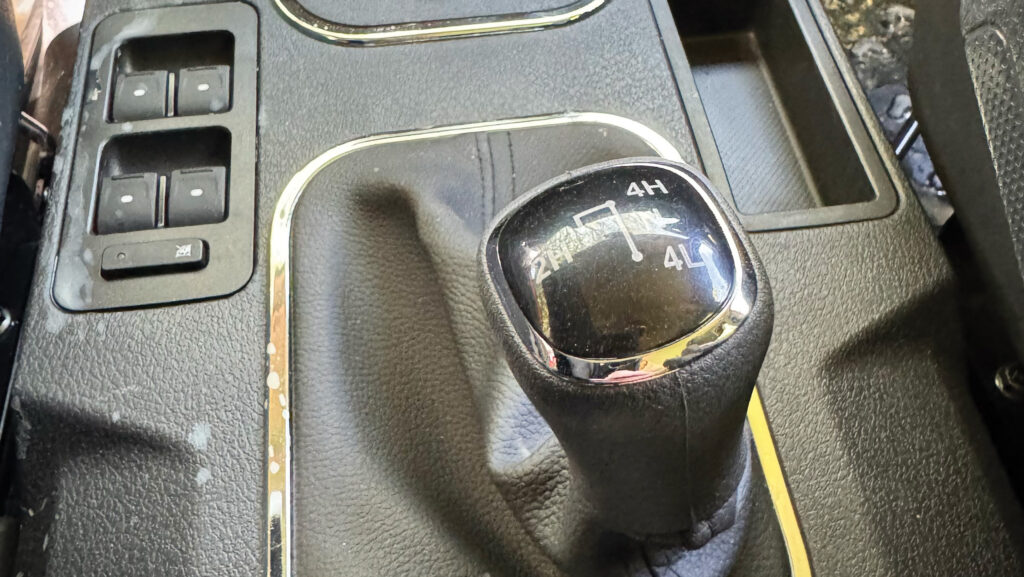
© MAG/Oliver Mark
What’s it like to drive?
Slow – by EV standards, at least. Top speed is limited to 90mph and, though there’s no official 0-62mph time, it’s undoubtedly a plodder.
And while it’s not one to be chucked at corners, the coil springs do a surprisingly good job of treading the line between suppressing off-road bounce and on-road body roll.
There is also a handful of extra features, including basic cruise control and a hill descent system.
With no engine braking on which to call, the latter – which uses the electric motor rather than the brakes to maintain a set speed of 1-9mph – is critical.
It’s an effective setup, though too easy to forget to disengage after accelerating away from a slope; the limiter will thump back into play as the throttle is released, with enough ferocity to knock out a few teeth.
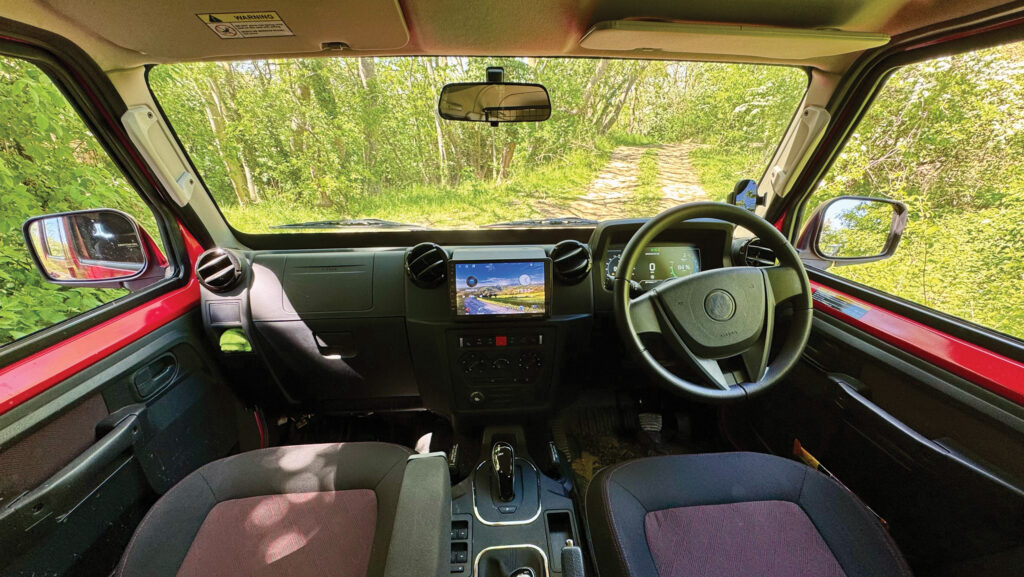
© MAG/Oliver Mark
Decent interior spec?
Hill descent and the hill hold function are selected on centre console buttons in a plain but functional cabin.
Cladding materials are the fit-where-they-touch sort and put out the odd squeak and rattle, though ears tend to be more sensitive to these things without the din of an engine to disguise them.
Standard features include a large central touchscreen that, on newer models, will run Android Auto, and there’s air conditioning, electric windows, central locking and a tyre pressure monitoring system.
The one notable disappointment is the lack of struts or linkages to hold the doors open. As it is, straps stop them swinging too far, and they need a blooming good thump to close.
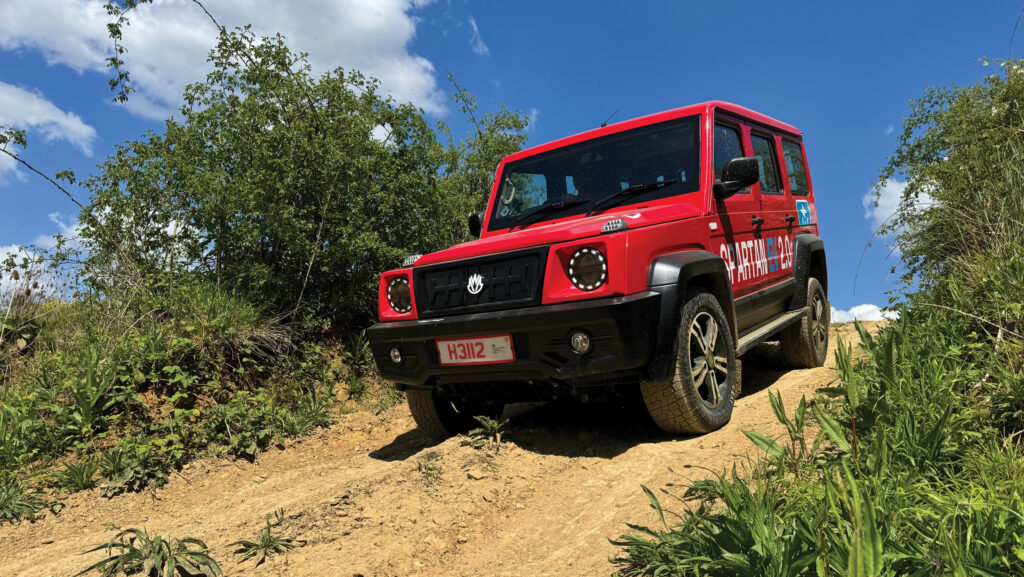
© MAG/Oliver Mark
Farmers Weekly verdict
A poor man’s Mercedes G-Wagon it may be, but this lookalike has plenty going for it – the post-motor driveline is simple, the spec pretty good and off-road ability far better than the average electric 4×4.
The issue might be the £53,000 price of the five-door six-seater, which puts it up against less hardcore but far more polished foes.
Some farming buyers may be happy to stretch to that, but the lion’s share of sales will likely come from corporate entities – National Trust, National Grid, mines and quarries – where the Spartan’s green credentials and off-road prowess will make it an appealing successor to their smutty old Defender 90s.
Despite its undoubted character, as a private vehicle it might struggle to win over heads as well as hearts.
Likes and gripes
Likes
- Surprisingly comfortable
- Good ground clearance
- Mechanical drive to the wheels
Gripes
- Limited range
- Unproven powertrain
- No transmission park position

